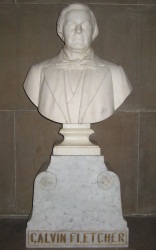
Indiana State Senator
- State Attorney for the 5th Judicial Circuit
- Early Indianapolis Land Developer
- First Lawyer in Indianapolis
Bust Location
Statehouse Rotunda
4th floor, Facing west
north corner
Born
Ludlow, Vermont
Lived
Indianapolis
Calvin Fletcher was born into a farming family in Ludlow, Vermont on February 4, 1798. He was the 11th of 15 children, and due to financial limitations, was only able to attend local schools intermittently.1 In April of 1817, Calvin left home, heading to Boston where he hoped to gain passage on a ship. Failing at that, he returned westward and travelled to Pennsylvania, where he worked as a laborer at random jobs when available. From there, Fletcher continued on to Urbana, Ohio. When he arrived there, he became employed as a teacher. In the fall of 1817, Fletcher began to study law in the office of James Cooley. In 1821, Fletcher was admitted to the Indiana Bar Association and became the law partner of James Cooley. On May 1, 1821, Fletcher married Sarah Hill, who had been a student of his.2
It was in the same year (1821) that Indianapolis was first named and laid out as the future capital of Indiana. That September, Fletcher packed up his wife and their belongings in a wagon and travelled for 14 days from Urbana to Indianapolis. When he arrived there on October 1, the city was in its infancy, and he was able to secure lodging in a cabin. Fletcher soon opened up his own law practice in the young city, becoming the first lawyer in Indianapolis.3 In 1822, Fletcher “started on the circuit,” which required Fletcher to travel extensively in the area surrounding Indianapolis for two-three months a year. Led by the President Circuit Judge, lawyers within that jurisdiction were required to travel together and hear cases throughout the circuit. It was during his 22 years of regular circuit travel that Fletcher made many of his professional and social acquaintances, gaining notoriety for his character.4
Calvin and Sarah Fletcher had their first son, James Cooley Fletcher, in April of 1823. He would be the first of 11 children. In the few years since the Fletchers had moved to Indianapolis, they became prominent figures among the first settlers of the area. Calvin became involved in land prospects, purchasing plots of land when he could and selling them later in order to triple or quadruple his original investment. It was in this way that Fletcher was able to amass the majority of his fortune. Fletcher’s story is an example of a “rags to riches” story, but the Fletchers were not ostentatious about their wealth, and were known and liked for their simple lifestyle.5
In 1825, Fletcher was appointed the State Attorney for the Fifth Judicial Circuit, which placed him in charge of over a dozen counties. After one year in this position, Fletcher was elected to the Indiana State Senate, where he served for seven years until he decided to resign and return to his private life. It was then, in 1834, that Fletcher was appointed by the State Legislature to serve on a group which would organize the first state bank. He became Sinking Fund Commissioner of the bank, which is a position that he filled for seven years.6 In 1836, Fletcher was approached with a proposal to run as a candidate for Congressional seat as a representative of Indiana, but he declined the offer. In 1843, Fletcher officially retired from his law practice, assuming the position of president of the branch office of the State Bank at Indianapolis. From then on, banking received Fletcher’s greatest attention, apart from the operation of his 1,600-acre farm on the outskirts of the city. Calvin Fletcher died on May 26, 1866 as a result of injuries that he received when he was thrown from his horse.7
While Calvin Fletcher did not serve in a statewide public office for the majority of his career as most of the other bust subjects have, what he has been commemorated for with his bust in the State House is his prominent position within Indianapolis throughout its development. As one of the original settlers, Fletcher’s social, political and professional lives are inextricably tied with the early development of Indianapolis. As avid diarists, both Calvin and Sarah Fletcher made records of not only their personal lives, but the lives of other prominent individuals and the history of Indianapolis. For example, the Fletchers were involved in the “voluntary association” craze of the 1830s, helping to create and becoming involved in a number of social groups in Indianapolis. These include the Marion County Temperance Society (1830s-40s), Marion County Agricultural Society (1835), the Indiana Mutual Fire Insurance Company (1837), The Indiana Colonization Society (1829) and the Indianapolis Female Institute (1836). In reading Fletcher’s accounts of his life from this period, one can also gain a real sense of Indianapolis’ early history and society.8
Bust History
The bust of Calvin Fletcher is currently located on the fourth floor of the Indiana Statehouse, occupying a niche outside of the central rotunda on the west side. Prior to this, the bust was located in a separate niche on the third floor of the Statehouse, just outside of the south door to the Senate chamber. It was moved to the fourth floor, and a bust of former Indiana Governor Frank L. O’Bannon was put in its place.9
